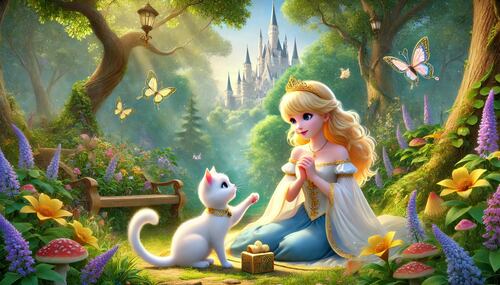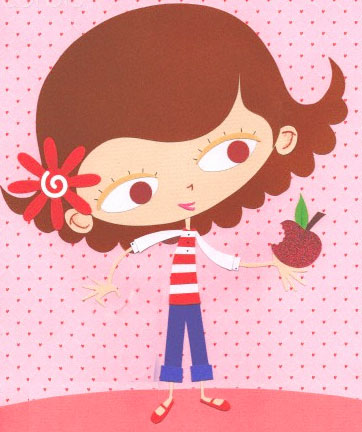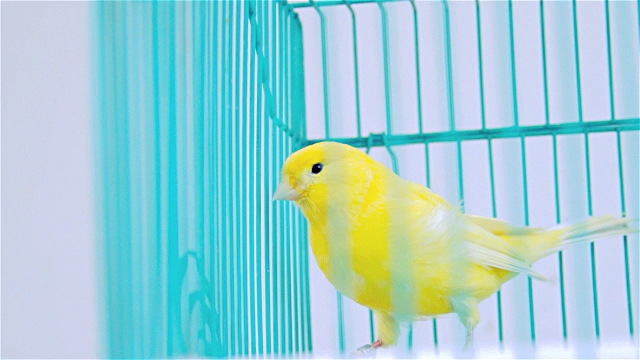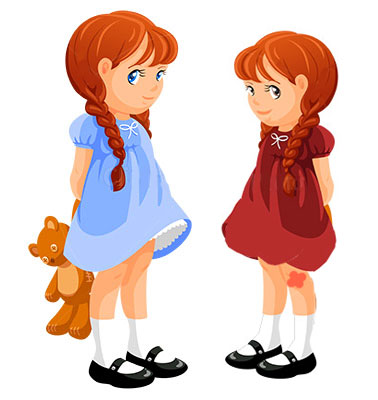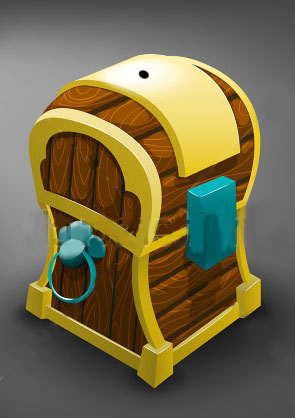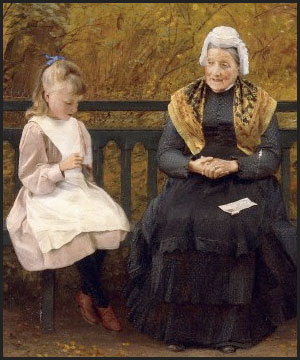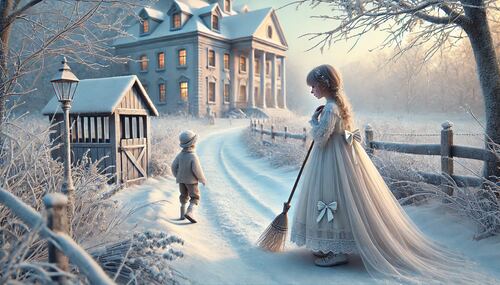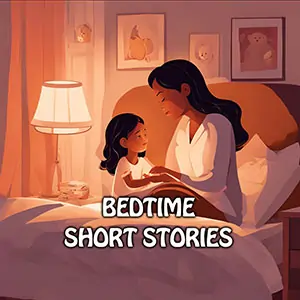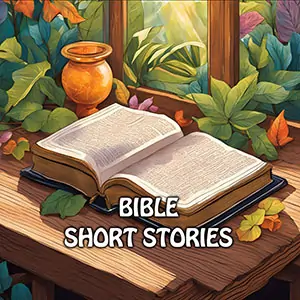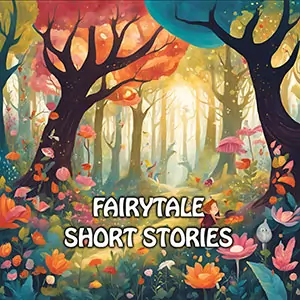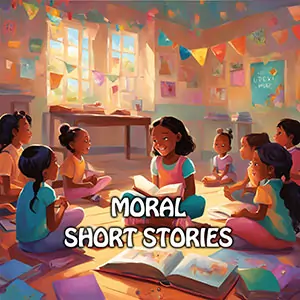Short Stories » The Last Leaf
Here is an abridged version of the world-famous short story titled ‘The Last Leaf’, by the gifted American writer O. Henry. Read about friendship and love. Read about how an artist’s masterpiece becomes life-saving art for another.
The Last Leaf
📢 Click the Play button to listen to this story aloud.
In a small district near Washington Square, there was a strange village called Greenwich Village, where many artists lived in their studios. Among them were Joanna, called ‘Johnsy’, and Sue.
Johnsy and Sue had their studio at the top of a three-story brick building. They had come from different parts of the world: one from California, and the other from Maine. They had many tastes in common, and so had decided to rent a studio together.
As the seasons changed, in November, in the bitter cold, many artists in the village caught pneumonia. Unfortunately, Johnsy caught the dreadful disease. She lay on her bed, hardly able to move, looking through the small Dutch window-panes at the wall of the next brick house.
One morning, after checking on Johnsy, her doctor took Sue aside and talked to her.
“She will survive only if she really wants to live, but she looks as though she has lost all hope. She should have the want to live. That is her only chance. Is she disappointed about something?”
“She was dreaming of painting the Bay of Naples some day, but now it seems like she is just awaiting her death,” replied Sue softly.
“If my patients start thinking about their own funeral, the medicines will not work for them. You should get your friend to think about something positive. If you can get her to think about living instead of dying, then she has a chance.”
Sue wiped her tears, plastered a smile on her face, and went into Johnsy’s room with her drawing board, humming a joyful song. Johnsy was lying with her face towards the window. Sue stopped humming, thinking that she was sleeping.
As she started a pen-and-ink drawing, she heard a low sound from Johnsy’s bed. She quickly went to the bedside.
Johnsy was looking out of the window intently, and counting. Sue listened closer. Johnsy was counting backward.
“Twelve,” she said, and a while later, “eleven”, and then after a while, “ten”, and then “nine.”
Sue looked out of the window. She could not see anything other than the blank side of the neighbouring brick house. Then she saw an old ivy vine that had climbed half way up the brick wall, but was decayed at the roots. The autumn wind had blown most of its weak leaves away, until just a couple more were remaining. The almost bare vine clung to the bricks, with just a few leaves left.
"What is it, dear?" Sue asked.
“Six,” whispered Johnsy. “Now falling fast! I am sure three days back there were almost a hundred leaves. There goes another. There are only five leaves left now.”
“Tell me, dear. Five what?”
“Leaves. On the ivy vine. When the last one falls, I will go too. I know that. Didn’t the doctor tell you?”
“Oh, dear! Such nonsense! The vine has nothing to do with your getting well. The doctor this morning told me that your chances of getting well were – let me remember- yes, he said the chances were ten to one! Let me give you some broth now. Be a dear.”
“There goes the fifth one. Now only four more leaves to go. No…I don’t want any broth. I want to see the last leaf fall…. Then I’ll go too.”
“Johnsy, dear,” Sue spoke softly, close to her ear, “Just keep your eyes closed, and don’t look out of the window. I must hand in this drawing by tomorrow. I need the light to draw. Otherwise I would have drawn the shade down.”
“Why don’t you draw in the other room?”
“I want to be with you,” Sue said softly. “Try to get some sleep. I have to call Behrman up to be my model for the old hermit miner in my drawing. I’ll come back in a minute.”
Old Behrman lived on the ground floor beneath them. He was a painter. He was past sixty and had a long beard that was the main feature of his impish body. Behrman had had consistent failures as an artist. He talked about a masterpiece that he was going to paint soon, but had never got around to actually doing it.
Sue found Behrman, smelling of gin, in his dimly lighted den below. In one dark corner was a blank canvas on an easel that had been awaiting the brushstrokes of the masterpiece that Behrman was dreaming about, for twenty-five years. She told him about Johnsy's fancy about vine and its falling leaves, and how she felt terrified that Johnsy would die when the last leaf fell from the vine.
Old Behrman, with his characteristic contempt for ‘weakness’ in artists, shouted his contempt for such idiotic imaginings.
"Vass!" he cried. "Is dere people in de world mit der foolishness to die…”
Johnsy was asleep when they went upstairs. Sue pulled the shade down and went into the other room with Behrman. In there they looked out of the window fearfully at the ivy vine. They stared blankly at each other. There was just one leaf left.
Sue could not sleep that night, and in the morning she found Johnsy staring at the drawn green shade.
“Pull up the shade. I want to see.”
But, lo! Even after the beating rain and the horrendous gusts of wind, there stood the one ivy leaf against the brick wall. It was the last one, still dark green near its stem, but its serrated edges oddly highlighted with the colour of decay. It held on to the branch about twenty feet above the ground.
"There is the last one,” said Johnsy weakly. "I thought it would fall during the night. I heard the rain and the wind. I am sure it will fall today, and I shall die at the same moment.”
"Dear, dear!" whispered Sue, half-sobbing, “You are not going to die, my dear. Think of me. What would I do?"
But there was no answer from Johnsy. The most lonely thing in all the world is a soul as it gets ready to go on its mysterious, far journey. One by one, her bonds to friendship and to earth were being loosened.
The day progressed wearily, and even at dusk, they could see the lone ivy leaf bravely clinging to its stem against the brick wall. When night came, the wind blew again mercilessly, and the rain beat against the windows.
When the new day dawned, Johnsy wanted the shade up again. She looked at the vine.
The ivy leaf was still there.
For a very long time, Johnsy lay on her bed, looking at the leaf. Then she called Sue, who was making chicken broth over the stove.
“Sudie, I have not been a good girl,” said Johnsy. “See, something has made that last leaf cling on there, to show me how wicked I was.
Wanting to die is bad. Please bring me some broth- no, first bring me a hand-mirror.”
And hour later she said, "Sudie, some day I hope to paint the Bay of Naples."
Sue waited for the doctor’s visit.
“Things are looking up,” said the doctor. “With good nursing, your friend will live. Now I have to go to another case downstairs. Behrman- his name is. Sort of an artist. Pneumonia too. The attack is acute, as he is an old man. No hope for him. But I will take him to the hospital so that he is more comfortable.”
With new hope for Johnsy, Sue devoted her time to nursing and caring for her.
The next day, the doctor said, “She is out of danger now. Now all that is needed is good care and nutrition.”
That afternoon Sue found Johnsy, still on her bed, but happily knitting a scarf. Her eyes welled up. She went to her and hugged her.
"I have something to tell you, my dear,” Sue said. "It about Mr. Behrman. He died of pneumonia. In the hospital today. He was sick only two days. The janitor found him in his room downstairs, in terrible pain, on the first day. He was icy cold, and his clothes and shoes were very wet. They couldn't understand where he had been on such a terrible night. And then they found a lantern, and a ladder, scattered brushes, and a palette with green and yellow colours mixed on it, and - look out the window, dear, at the last ivy leaf on the wall. Didn't you wonder why it never fluttered or moved when the wind blew? Ah, darling, it's Behrman's masterpiece - he painted it there the night that the last leaf fell."
Image courtesy: oscareducation
Was this article useful?
We’d love to hear from you! Share your valuable feedback and suggestions to help us improve your experience and serve you better.
❤️ If you’re happy with our website, please consider supporting us — Donate Now!
🌟 Or leave a positive review here to encourage our team!
